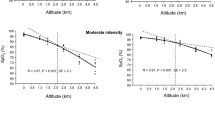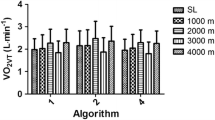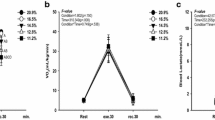Abstract
The factors determining maximal oxygen consumption were explored in eight endurance trained subjects (TS) and eight untrained subjects (US) exposed to moderate acute normobaric hypoxia. Subjects performed maximal incremental tests at sea level and simulated altitudes (1,000, 2,500, 4,500 m). Heart rate (HR), stroke volume (SV), cardiac output \({(\dot{{Q}})},\) arterialized oxygen saturation \({(\hbox{Sa}^{\prime}\hbox{O}_2)},\) oxygen uptake \({(\dot{{V}}\hbox{O}_{\rm 2max})},\) ventilation (\({\dot{{V}}{E}},\) expressed in normobaric conditions) were measured. At maximal exercise, ventilatory equivalent \({(\dot{{V}}{E}/\dot{{V}}\hbox{O}_{\rm 2max}),\, \hbox{O}_2}\) transport \({(\dot{{Q}}\hbox{aO}_{\rm 2max})}\) and O2 extraction (O2ERmax) were calculated. In TS, \({\dot{{Q}}_{\rm max}}\) remained unchanged despite a significant reduction in \({\hbox{HR}_{\rm max}}\) at 4,500 m. SVmax remained unchanged. \({\dot{{V}}{E}_{\rm max}}\) decreased in TS at 4,500 m, \({\dot{{V}}{E}/\dot{{V}}\hbox{O}_{\rm 2max}}\) was lower in TS and greater at 4,500 m vs. sea level in both groups. Sa′O2max decreased at and above 1,000 m in TS and 2,500 m in US, O2ERmax increased at 4,500 m in both groups. \({\dot{{Q}}\hbox{aO}_{\rm 2max}}\) decreased with altitude and was greater in TS than US up to 2,500 m but not at 4,500 m. \({\dot{{V}}\hbox{O}_{\rm 2max}}\) decreased with altitude but the decrement \({(\Delta \dot{{V}}\hbox{O}_{\rm 2max})}\) was larger in TS at 4,500 m. In both groups \({\Delta \dot{{V}}\hbox{O}_{\rm 2max}}\) in moderate hypoxia was correlated with \({\Delta \dot{{Q}}\hbox{aO}_{\rm 2max}}.\) Several differences between the two groups are probably responsible for the greater \({\Delta \dot{{V}}\hbox{O}_{\rm 2max}}\) in TS at 4,500 m : (1) the relative hypoventilation in TS as shown by the decrement in \({\dot{{V}}{E}_{\rm max}}\) at 4,500 m (2) the greater \({\dot{{Q}}\hbox{aO}_{\rm 2max}}\) decrement in TS due to a lower Sa′O2max and unchanged \({\dot{{Q}}_{\rm max}}\) 3) the smaller increase in O2ERmax in TS, insufficient to compensate the decrease in \({\dot{{Q}}a\hbox{O}_{\rm 2max}}.\)





Similar content being viewed by others
References
Adams RP, Welch HG (1980) Oxygen uptake, acid–base status, and performance with varied inspired oxygen fractions. J Appl Physiol 49:863–868
Altman PL (1961) Blood O2 dissociation line charts. In: Dittmer DS (ed) Biological handbook. Blood and other body fluids. Federation of American societies for experimental biology, chap 7, p 165
Benoit H, Busso T, Castells J, Devis C, Geyssant A (1995) Influence of hypoxic ventilatory response on arterial O2 saturation during maximal exercise in acute hypoxia. Eur J Appl Physiol 72:101–105
Calbet JAL, Boushel R, Radegran G, Sodergaard H, Wagner PD, Saltin B (2003) Determinant of maximal oxygen uptake in severe acute hypoxia. Am J Appl Physiol Regul Integr Comp Physiol 284:R291–R303
Chapman RF, Emery M, Stager JM (1999) Degree of arterial desaturation in normoxia influences \({\dot{V}\hbox{O}_{\rm 2max}}\) decline in mild hypoxia. Med Sci Sports Exerc 31:658–663
Charloux A, Lonsdorfer-Wolf E, Richard R, Lampert E, Oswald-Mammosser M, Mettauer B, Geny B, Lonsdorfer J (2000) A new impedance cardiograph device for the non-invasive evaluation of cardiac output at rest and during exercise: comparison with the “direct” Fick method. Eur J Appl Physiol 85:313–320
Dempsey JA, Hanson PG, Pegelow D, Claremont A, Rankin J (1982) Limitations to exercise capacity and endurance: pulmonary system. Can J Appl Sport Sci 7:4–13
di Prampero PE, Ferretti G (1990) Factors limiting maximal oxygen consumption in humans. Respir Physiol 80:113–27
Ekblom B, Huot R, Stein EM, Thorstensson AT (1975) Effect of changes in arterial oxygen content on circulation and physical performance. J Appl Physiol 39:71–75
Fajac J, Texereau V, Rioval V, Dessanges J-F, Dinh-Xuan AT, Dall’Ava-Santucci J (1998) Blood gas measurement during exercise: a comparative study between arterialized earlobe sampling and direct arterial puncture in adults. Eur Respir J 11:712–715
Ferretti G, Moia C, Thomet JM, Kayser B (1997) The decrease of maximal oxygen consumption during hypoxia in man: a mirror image of the oxygen equilibrium curve. J Physiol 498:231–237
Fulco CS, Rock PB, Cymerman A (1998) Maximal and submaximal exercise performance at altitude. Aviat Space Environ Med 69:793–801
Gore CJ, Hahn AG, Scroop GC, Watson DB, Norton KI, Wood RJ, Campbell DP, Emonson DL (1996) Increased arterial desaturation in trained cyclists during maximal exercise at 580 m altitude. J Appl Physiol 80:2204–2210
Hartley LH, Vogel JA, Landowne M (1973) Central, femoral, and brachial circulation during exercise in hypoxia. J Appl Physiol 34:87–90
Hillier SC, Graham JA, Hanger CC, Godbey PS, Glenny RW, Wagner WW (1997) Hypoxic vasoconstriction in pulmonary arterioles and venules. J Appl Physiol 82:1084–1090
Hogan MC, Roca J, Wagner PD, West JB (1988) Limitation of maximal O2 uptake and performance by acute hypoxia in dog muscle in situ. J Appl Physiol 65:815–821
Hogan MC, Roca J, West JB, Wagner PD (1989) Dissociation of maximal O2 uptake from O2 delivery in canine gastrocnemius in situ. J Appl Physiol 66:1219–1226
Hopkins SR, Bogaard HJ, Niizeki K, Yamaya Y, Ziegler MG, Wagner PD (2003) Beta-adrenergic or parasympathetic inhibition, heart rate and cardiac output during normoxic and acute hypoxic exercise in humans. J Physiol 15:605–616
Horstman D, Weiskopf R, Jackson RE (1980) Work capacity during 3-wk sojourn at 4,300 m: effects of relative polycythemia. J Appl Physiol 49:311–318
Hughes RL, Clode M, Edwards RHT, Goodwin TJ, and Jones NL (1968) Effect of inspired O2 on cardiopulmonary and metabolic responses to exercise in man. J Appl Physiol 24:336–347
Lamberto C, Nunes H, Le Toumelin P, Duperron F, Valeyre D, Clerici C (2004) Membrane and capillary blood components of diffusion capacity of the lung for carbon monoxide in pulmonary sarcoidosis: relation to exercise gas exchange. Chest 125:2061–2068
Lawler J, Power SK, Thompson D (1988) Linear relationship between \({\dot{V}\hbox{O}_{\rm 2max}\,\hbox{and}\,\dot{V}\hbox{O}_{\rm 2max}}\) decrement during exposure to acute hypoxia. J Appl Physiol 64:1486–1492
Martin D, O’Kroy J (1993) Effects of acute hypoxia on the \({\dot{V}\hbox{O}_{\rm 2max}}\) of trained and untrained subjects. J Sports Sci 11:37–42
McGuire BJ, Secomb TW (2004) Theoretical predictions of maximal oxygen consumption in hypoxia: effect of transport limitations. Resp Physiol Neurobiol 143:87–97
Peltonen JE, Tikkanen HO, Rusko HK (2001) Cardiorespiratory responses to exercise in acute hypoxia, hyperoxia and normoxia. Eur J Appl Physiol 85:82–88
Powers SK, Dodd S, Lawler J, Landry G, Kirtley M, McKnight T, Grinton S (1988) Incidence of exercise induced hypoxemia in elite endurance athletes at sea level. Eur J Appl Physiol Occup Physiol 58:298–302
Richalet J-P, Kéromès A, Dersch B, Corizzi F, Mehdioui H, Pophillat B, Chardonnet H, Tassery F, Herry J-P, Rathat C, Chaduteau C, Darnaud B (1988) Caractéristiques physiologiques des alpinistes de haute altitude. Sci Sports 3:89–108
Richard R, Lonsdorfer-Wolf E, Charloux A, Doutreleau S, Buchheit M, Oswald-Mammosser M, Lampert E, Mettauer B, Geny B, Lonsdorfer J (2001) Non-invasive cardiac output evaluation during a maximal progressive exercise test, using a new impedance cardiograph device. Eur J Appl Physiol 85:202–207
Riley R, Lilienthal J, Proemmel D, Frankee R (1946) On the determination of the physiologically effective pressure of oxygen and carbon dioxide in alveolar air. Am J Physiol 147:191–198
Robergs RA, Quintana R, Parker DL, Frankel CC (1998) Multiple variables explain the variability in the decrement in \({\dot{V}\hbox{O}_{\rm 2max}}\) during acute hypobaric hypoxia. Med Sci Sports Exerc 30:869–879
Roca J, Hogan MC, Story D, Bebout DE, Haab P, Rodriguez R, Ueno O, Wagner PD (1989) Evidence for tissues diffusion limitation of \({\dot{V}\hbox{O}_{\rm 2max}}\) in normal humans. J Appl Physiol 67:291–299
Roca J, Agusti AGN, Alonso A, Poole DC, Viegas C, Barbera JA, Rodriguez-Roisin R, Ferrer A, and Wagner PD (1992) Effects of training on muscle O2 transport at \({\dot{V}\hbox{O}_{\rm 2max}}.\) J Appl Physiol 65:1067–1076
Saltin B, Calbet JAL (2006) Point: in health and in normoxic environment \({\dot{V}\hbox{O}_{\rm 2max}}\) is limited primarily by cardiac output and locomotor muscle blood flow. J Appl Physiol 100:744–745
Squires RW, Buskirk ER (1982) Aerobic capacity during acute exposure to simulated altitude, 914 to 2286 meters. Med Sci Sports Exerc 14:36–40
Stenberg J, Ekblom B, Messin R (1966) Hemodynamic response to work at simulated altitude, 4000 m. J Appl Physiol 21:1589–1594
Terrados N, Mizuno M, and Andersen H (1985) Reduction in maximal oxygen uptake at low altitudes, role of training status and lung function. Clin Physiol 5(suppl. 3):75–79
Torre-Bueno JR, Wagner PD, Saltzman HA Gale GE, and Moon RE (1985) Diffusion limitation in normal humans during exercise at sea level and simulated altitude. J Appl Physiol 58:989–995
Wagner PD (1982) Influence of mixed venous PO2 on diffusion of O2 across the pulmonary blood: gas barrier. Clin Physiol 2: 105–115
Wagner PD (1988) An integrated view of the determinants of maximal oxygen uptake. Adv Exp Med Biol 227:245–256
Wagner PD (1993) Algebraic analysis of the determinants of VO2max . Respir Physiol 93:221–37
Wagner PD (2006) Counterpoint: in health and in normoxic environment \({\dot{V}\hbox{O}_{\rm 2max}}\) is not limited primarily by cardiac output and locomotor muscle blood flow. J Appl Physiol 100:745–748
Wagner PD, Gale GE, Moon RE, Torre-Bueno JR, Stolp BW, Saltzman A (1986) Pulmonary gas exchange in humans exercising at sea level and simulated altitude. J Appl Physiol 61:260–270
Welsman J, Bywater K, Farr C, Welford D, Armstrong N (2005) Reliability of peak VO(2) and maximal cardiac output assessed using thoracic bioimpedance in children. Eur J Appl Physiol 94:228–34
Woorons X, Mollard P, Lamberto C, Letournel M, Richalet JP (2005) Effect of acute hypoxia on maximal exercise in trained and sedentary women. Med Sci Sports Exerc 37:147–154
Acknowledgments
The authors thank all the volunteers for their participation in this study and the technicians of the “Service de physiologie, explorations fonctionnelles et médecine du sport” of Avicenne Hospital, Bobigny for their help.
Author information
Authors and Affiliations
Corresponding author
Rights and permissions
About this article
Cite this article
Mollard, P., Woorons, X., Letournel, M. et al. Determinants of maximal oxygen uptake in moderate acute hypoxia in endurance athletes. Eur J Appl Physiol 100, 663–673 (2007). https://doi.org/10.1007/s00421-007-0457-0
Accepted:
Published:
Issue Date:
DOI: https://doi.org/10.1007/s00421-007-0457-0




